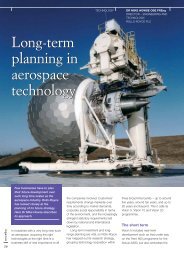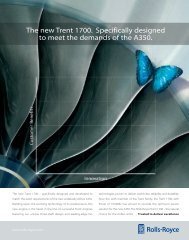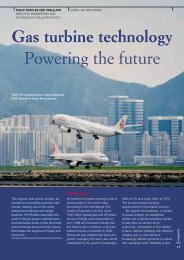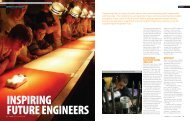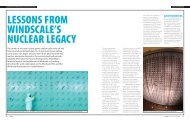[442-07] Newton - Ingenia
[442-07] Newton - Ingenia
[442-07] Newton - Ingenia
Create successful ePaper yourself
Turn your PDF publications into a flip-book with our unique Google optimized e-Paper software.
MANUFACTURING<br />
processors. We had begun to doubt<br />
some of the design bases that had<br />
been used for designing commercialscale<br />
fluidised bed process hardware.<br />
During 1985 to 1991, whilst working at<br />
UCL, we did find many discrepancies<br />
between phenomena and data<br />
determined from the X-ray technique<br />
and those conforming to an<br />
‘established view’. Many of these<br />
findings have been published. 2–4<br />
ingenia<br />
48<br />
Figure 1: Schematic of the X-ray technique<br />
imaging to visualise the internal flow<br />
patterns of bubbles in gas fluidised<br />
beds. Since those early pioneering days<br />
there have been many hundreds of<br />
publications dealing with the properties<br />
of gas fluidised beds obtained from the<br />
X-ray imaging technique, 1 a significant<br />
proportion of them coming from UCL<br />
as scientific papers or PhD theses. In<br />
1965 Peter Rowe left AERE and moved<br />
to UCL as Ramsay Head and Professor<br />
of Chemical Engineering. Since then the<br />
technique has flourished over the years<br />
at UCL, mainly through the efforts of<br />
Peter Rowe (who retired in 1985), John<br />
Yates (current Head of Chemical<br />
Engineering at UCL), David Cheesman<br />
and, more recently, Paola Lettieri.<br />
Back in 1985 BP Research began<br />
what was to be a long and very fruitful<br />
relationship with the Department of<br />
Chemical Engineering at UCL. Over the<br />
following seven years BP (and others,<br />
such as The Dupont Chemical Co.)<br />
used and helped develop the facility at<br />
UCL. At that time, we were driven by<br />
the need to understand what was going<br />
on inside some of our gas fluidised bed<br />
Figure 2: Schematic of the recirculating loop configuration employed by BP<br />
How does it work?<br />
Differences in X-ray absorbance of the<br />
components (i.e. solids, liquids or<br />
gases) present in a reactor vessel allow<br />
hydrodynamic information to be<br />
determined. X-rays do not interact with<br />
the hydrodynamic processes and<br />
therefore do not disturb the<br />
measurements, in contrast to<br />
techniques that use intrusive probes. In<br />
the X-ray technique a pulsed (typically<br />
50 Hz) high energy beam (from 40 to<br />
150 kV) is produced from a rotating<br />
anode. The X-ray pulses (typically<br />
between 1 and 5 ms in duration for<br />
rapidly fluctuating multiphase systems)<br />
are synchronised with an image<br />
capturing device and pass through the<br />
reactor vessel, where X-ray absorption<br />
is proportional to the nature and<br />
quantity of material along the path.<br />
Rapid X-ray pulses of a few<br />
milliseconds duration are essential for<br />
accurate quantitative work.<br />
The X-ray beam emerging from the<br />
reactor vessel is amplified using an<br />
image intensifier, without which it would<br />
be impossible to detect the small<br />
changes of intensity in the emerging X-<br />
ray beam. The image intensifier tube<br />
converts the X-ray absorption patterns<br />
into a light image of sufficient<br />
brightness and contrast to be recorded<br />
by some means, typically photographic<br />
film (cine camera), charge coupled<br />
device or video camera. Figure 1 shows<br />
a schematic of the X-ray system and<br />
Figure 2 shows a schematic of the BP<br />
recirculating loop configuration for<br />
imaging a 750 mm diameter fluidised<br />
bed unit.


![[442-07] Newton - Ingenia](https://img.yumpu.com/23411218/2/500x640/442-07-newton-ingenia.jpg)


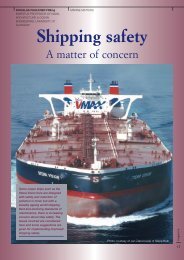


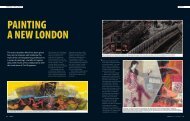
![[322/03] Francke - Ingenia](https://img.yumpu.com/23411337/1/184x260/322-03-francke-ingenia.jpg?quality=85)

